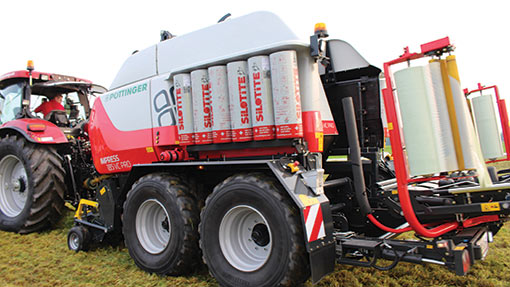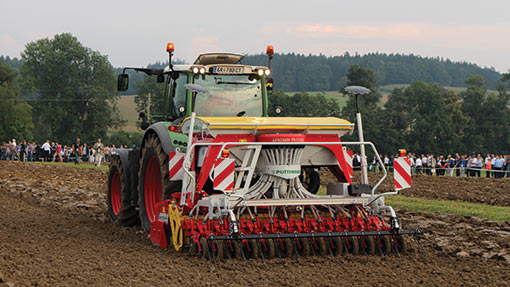First Pottinger round baler and latest Aerosem seed drills revealed

Pottinger has never been a company to rush into launching a product simply to cash in on a trend. Instead, it bides its time, looks at what farmers are buying and develops products that frequently offer something different, according to UK general manager, Shaun Groom.
This is exactly what it has done with the launch of a new product segment for the company – round balers. Although the company has been producing other forage harvesting kit – such as forage wagons – for more than 50 years, the Impress is the first round baler to be wholly Pottinger-built.
See also: Pottinger updates cultivator range
Its only previous foray into this market was a range of rebadged Gallignani balers aimed at central European markets.
Thanks to the experience of designing and making pick-ups for its forage wagons, the firm believes it can bring a new level of technology to the round baler market, explains Mr Groom.
Over, rather than under
“The biggest difference with the Impress baler is that material is fed over the pick-up rather than under it, as with almost all other balers on the market,” he says.
The Impress is made for all types of forage, from hay and straw right through to the heaviest crops of grass.
The 32-knife chopping system is not only mounted on a galley system that can be drawn out easily by the operator, but is also reversible for quicker turnaround.
Because there are 32 knives, says Pottinger, that chop length is 20% shorter than on any other competitor model, too.
The variable chamber baler has three belts, and all material is fed from the top, with the rotor effectively running in reverse.
That enables the knife system to be mounted higher to allow all knife maintenance to be done while standing up rather than from underneath.
Unlike other baler-wrapper configurations, which use satellite arms at the top that rotate while wrapping, the spindle on the Impress 185 VC Pro is located underneath.
This, says the company, results in less strain on the arms themselves, with the chances of inconsistent wrapping from effects such as bounce greatly reduced.
“Although the balers have been tested on farms for several seasons, we wanted to be confident that they could handle all possible conditions before announcing them to the market.”
Aerosem 1002

First shown at Agritechnica last November, the latest range of Aerosem pneumatic seed drills uses the company’s new intelligent distribution system (IDS) and precision combi seeding (PCS) system, which make the drill a true all-rounder for farmers and contractors, says Mr Groom.
Available in 3m, 3.5m, and 4m working widths, the new range can be specced to deliver four types of drilling from one machine – cereals, maize, grain and fert, as well as undersowing.
Metering wheels can be changed without tools and the metering system can cope with anything from 1.5kg up to 340kg.
The distributor head can be fitted with three types of outlet: uncontrolled (for non-tramline or non-controlled), controlled outlets with mechanical metering, or controlled with electronic metering, which allows the operator to set outlets via the in-cab controller or tractor’s Isobus system.
Models with the electronic metering get the IDS, allowing for tramline widths, track widths, special tramline switching and automatic seed flow reduction for tramlines. “This can reduce seed rates by up to 6%,” adds Mr Groom.
A wide-opening multi-compartment hopper holds 1,250 litres and can be split depending on whether grain and fert, or grain and even grass seed is being used.
For those wanting to drill maize or other precision-sown crops, the PCS is a mechanical single-seed unit, which remains on the conventional drill and can be configured to work in a manner of minutes.
The drill is fitted with 10 individual dual-disc seed elements and fertiliser can also be applied between the seed rows.
The separation system on the drill is mechanical and individual grains are conveyed to the coulter under pressure.
That means seed placement is more accurate thanks to a lower drop than air systems, which can otherwise result in seed bouncing out of the row, he explains.
The big difference with the Impress baler is that material is fed over the pick-up rather than under it.
Aerosem can drill cereals, maize, grain and fertiliser as well as undersowing.

